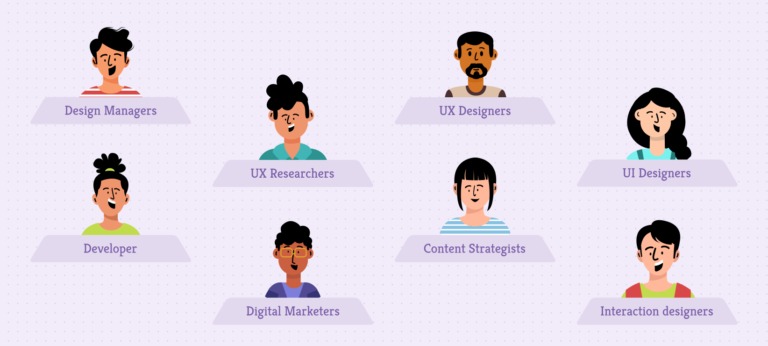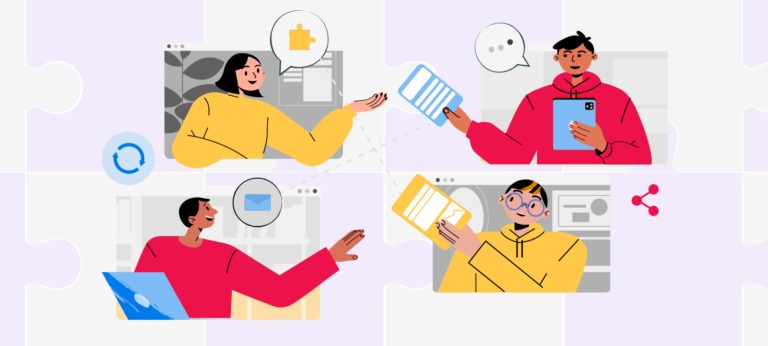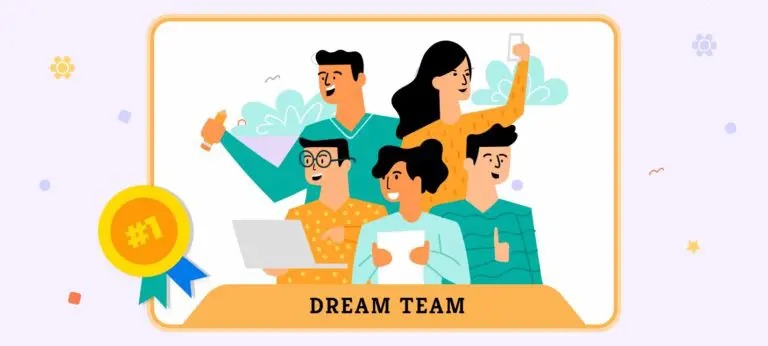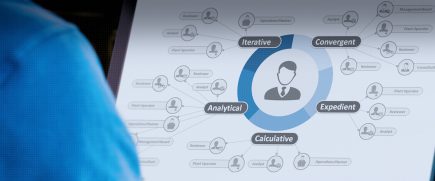The success of a product in this digital era is marked by critical aspects that ultimately boil down to how accessible it is. It hinges not only on its functionality but also on how it feels and looks to the user. A well-rounded design team is essential for creating products that are not only usable but also delightful and efficiently solve all user pain points. This team typically includes a variety of specialized UX roles, each contributing unique skills and perspectives. From User Research to User Experience (UX) and Visual Design and everything in between, these roles work together to ensure a seamless and engaging user experience.
However, organizations and agencies often fall short when trying to recognize the need for certain roles that together make the dream UI/UX design team. This blog will explore these essential roles, highlighting the responsibilities and importance of each, and help you identify the traits that make for a better UX professional.
Stuti Mazumdar & Vidhi Tiwarii - August 2024

Understanding the Design Team Structure
Before diving into the specific UX roles, it’s important to understand the broader structure of a functioning design team. A design team can vary in size and composition depending on the organization and project needs. Each role plays a critical part in the design process, starting from initial research to the final visual touches. So, let’s explore these roles in more detail.

1. UX Researchers
UX researchers are the foundation of the design process since they conduct user research. Their primary responsibility is to understand the users, that is, the target audience—including who they are (user personas), what they need (users’ wants and needs), and how they behave (user behavior). They employ various research methods such as user interviews, surveys, usability testing, and many other qualitative and quantitative research methods, to gather insights that inform design decisions.
By setting the foundations of the design process in user research, UX researchers help ensure that the product solves a real-world problem, meeting user needs. This user-centered approach increases the likelihood of user satisfaction and product success.
2. UX Designers
UX designers use the insights gathered by UX researchers to create user-friendly journeys. They focus on the overall structure and flow of the product, by crafting the information architecture first and then moving on to designing the wireframes and prototypes to map out user journeys. Their goal is to make the product intuitive and easy to navigate.
UX designers help translate user needs into design requirements that help the team in building the final product, after all, they are the forces behind the mechanics of a digital product. They ensure that the design is both functional and enjoyable, making it easy for users to achieve their goals without frustration.
3. UI Designers
User interface designers focus on the visual aspects of the user interface, as opposed to the UX designers who focus on how a product works. They collaborate closely with other UX professionals in the members—including content strategists, interaction designers, and developers, to work on the overall layout as well as the typography, color schemes, and interactive elements, ensuring that the product is aesthetically pleasing and aligned with the brand’s visual guidelines.
UI designers play a crucial role in creating attractive and engaging interfaces that are sticky to every user. In addition, they carefully make design decisions based on color theory, scannability, hierarchy, content blindness, etc. to create accessible digital products.
4. Interaction Designers
A team may or may not have a specialized interaction designer since their role often gets absorbed into the duties of a UI designer. However, when hired for this particular skill set, interaction designers specialize in motion-led design that includes gestures on the screen, visual inputs/outputs, and haptic feedback on interaction with elements. They create detailed designs for buttons, forms, animations, and other interactive components, ensuring that each interaction is smooth and intuitive.
Interaction Designers ensure that users can interact with the product seamlessly, leading to a more engaging and satisfying experience.
5. Content Strategists and Writers
Content strategists are responsible for planning, creating, and managing content across the product and beyond. They ensure that the content is clear, accessible, and aligned with the users’ needs and the products’ goals. This includes everything from microcopy in the interface to longer-form content.
Content strategists and designers typically begin the process in collaboration with UX researchers and conduct user research. Insights help power their decisions when crafting micro-copy throughout the app for a better user experience and effective content strategy, ensuring that users receive the right information at the right time.
Additionally, they work with UX designers to create information architecture since it is closely linked to the navigation and communication design throughout the product.
6. Digital Marketers
Digital Marketers contribute to the product’s first impression. They help craft an attractive brand personality to capture user interest and convey the brand’s vision, making the product more memorable and appealing.
Additionally, digital marketers help UX researchers conduct user surveys relevant to user behavior engaging in the domain. They analyze engagement and product adoption to influence product strategy and create launch campaigns. Their market surveys also help educate designers on user preferences when it comes to the aesthetics and appeal of the digital product.
They help maintain consistency in the copy and visuals across the product.
7. Developer
The development team is responsible for bringing the design to life via coding and technical implementation. They work closely with designers to ensure that the product design is implemented perfectly, allowing it to work as intended in the final product. This includes front-end development, back-end development, and integration with other systems. They are the backbone of any digital product, ensuring they are skilled in industry-leading technological trends that help organizations create better-performing digital products that adhere to data privacy laws globally.
Additionally, they provide stakeholders and the business unit with technological suggestions to improve functionality and create scalable solutions.
8. Design Managers
Design managers (often known as product managers) oversee the design team and its functions, ensuring that every design project is completed on time and meets quality standards. They are the bridge between the stakeholders and the design team, helping them understand the business requirements and converting the same into effective and actionable design problems to solve.
They also advocate on behalf of the team to gain enough time from the stakeholders to ensure quality of work at every step of the design process. They coordinate between different members, manage resources, and facilitate communication between the design team and other departments.
Effective design management is crucial for the smooth operation of the design team. Design managers ensure that the team works efficiently and that the final product aligns with the business goals and user needs.
How Can You Maximize Collaboration and Workflow?

1. Cross-Functional Collaboration at All Times
A successful design team doesn’t work in isolated groups of like-structured teams. Collaboration with other branches, such as business strategy, product management, development, and marketing is essential.
The secret ingredient here is to maximize regular communication and feedback to ensure that the design decisions made are feasible and aligned with the broader business objectives of the stakeholders/clientele.
2. Make Use of Agile and Iterative Processes
Many design teams adopt agile methodologies to ensure iterative development and constant improvement. This approach involves periodic cycles of strategy and planning, design, testing, feedback, and refinement, ensuring that the product evolves in response to user needs and feedback. This truly keeps the idea of user-centered design at the epicenter of the project.
3. Use Collaborative Tools
Since design teams rely on an assortment of online tools for each step of the process, an organization should make use of tools designed for close and efficient collaboration. Common tools include design software like Figma, InVision, Adobe XD, and Sketch for creating designs; project management tools like Jira and Trello to track progress and manage tasks; and much more.
What To Look For When Hiring A Dream Design Team?

When hiring a dream UI/UX design team, it is essential to evaluate personality traits that make for a great designer, just as we evaluate technical skills through various assessments. The right personality aspects can ensure effective collaboration, innovation, and a user-centered approach.
1. Empathy
Designers with the capability to stand in users’ shoes to view a problem as their own are essential. Those who demonstrate a strong ability to empathize with the users often show a genuine interest in solving user problems.
2. Curiosity
Curiosity drives continuous learning and improvement. With curiosity comes a strong sense of enthusiasm for learning new tools and techniques and staying updated with industry trends.
3. Collaboration
A UI/UX design team is built and functions on a collaborative process involving various stakeholders. Candidates who have experience working in team environments with cross-functional communication demonstrate the willingness to contribute in high-pressure environments of building a digital product at a global scale.
4. Adaptability
The design and technology landscape is constantly evolving, requiring adaptability to new challenges and technologies. Designers, developers, writers, and other UX professionals with varied experiences, who have successfully navigated changing project requirements or adopted new tools and methodologies, are often the right fit for the ever-evolving industry.
5. Analytical Thinking
Analyzing user data and research findings is crucial for making informed design decisions. Hence, it would be ideal for your design team members to be able to not only view and absorb data tables but also interpret them, perform research, and infer actionable design insights from the same.
6. Problem-Solving Skills
With analytical thinking comes a problem-solving mindset. Design often involves addressing user problems and finding effective solutions that may or may not involve design principles. At times like this, it is essential that your team hones the art of cooking up digital solutions that go beyond the basics.
7. User-Centric Mindset
User-centric design is the crux of creating products that outlast industry trends. A focus on the end user ensures that designs meet actual needs and enhance user satisfaction. UX professionals who prioritize user needs in their design process and have a strong understanding of user experience principles.
8. Passion for Design
We know it’s a little corny, but as an organization putting together a dream UI/UX team, it is safe to assume you’re looking for an individual passionate about design. After all, they are more likely to go the extra mile to create exceptional work. Find design professionals who express a genuine love for design, and are actively seeking opportunities to learn and improve.
Remember: when assembling your dream UI/UX design team, it’s important to balance technical skills with these key personality traits.
Building and Nurturing a Design Team
Now that you know who makes up your dream design team and what to look for, let’s dive deep into nurturing it.
1. Hiring Talent That’s Different
Building a successful design team starts with hiring the right talent—but ensuring that they’re not like-minded. Look for design professionals with various talents, work experiences, and backgrounds to ensure you have a wide variety of opinions and talent in your team. This brings to your team a strong technical skill set and also the possibility of creative solutions.
2. Fostering a Collaborative Culture
Encourage the teammates to collaborate closely and learn continuously. You can do so by conducting regular design presentations and workshops, design-athons, and other activities to foster creativity and improve communication.
3. Inspiring the Team
Always persuade the design team to encounter brilliant design—digital products, art, engineering projects, etc. Encourage consistent learning, seeking feedback, and iterating their own design to improve continually, ultimately developing better digital solutions for the consumption of global users.




